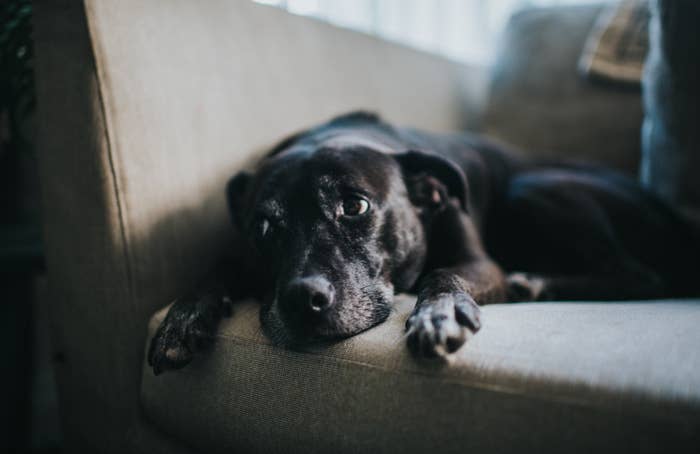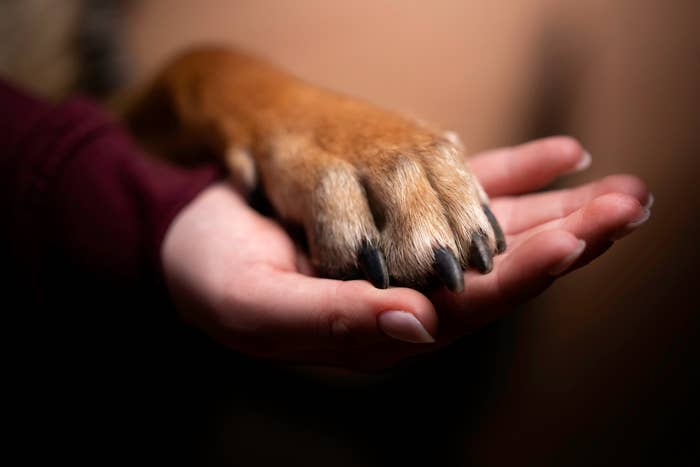
It’s estimated that one out of every four dogs will be diagnosed with cancer in their lifetime, and half of dogs over 10 will die from it. The disease, which occurs when some of the body’s cells grow uncontrollably and destroy healthy tissue, is becoming more common in our four-legged pals.
Scientists suspect this is due to a mix of factors, including their longer lifespan, selective breeding, environmental factors and improved diagnostic testing. Early detection can improve your dog’s chances of beating the disease and living a long, happy life.
However, because our pups can’t outright tell us if they’re in pain or feel off, most dogs aren’t diagnosed until the cancer’s in an advanced stage.
There are several clues that might indicate your dog has cancer ― and the sooner you spot them, the sooner they can be addressed. “As in humans, cancer is best treated when detected early,” Dr. Julie Bulman-Fleming, a veterinary oncologist and medical director of Veterinary Cancer Group, a Thrive Pet Healthcare partner, told HuffPost.
We asked three vets what the earliest signs of cancer are in dogs. Here’s what they said:
Your dog is behaving oddly

According to Bulman-Fleming, many dogs will start acting out of the ordinary. This is, she says, typically the very clue that a dog has cancer.
The behavior change can be so slight that it’s only noticeable to someone in the family. Your dog, for example, might suddenly stop begging for a treat when you prepare your coffee.
“It could be as subtle as no longer asking for breakfast, or sleeping in, or it can be more noticeable like avoiding their family or stopping on walks,” Bulman-Fleming said. They may also seem more lethargic than usual. “This can be mild or severe and may happen quickly or progress over days to weeks,” Rebhun said.
These types of routine or behavioral changes could indicate your dog is in pain. Most cancers cause systemic inflammation in the body and that inflammation can make your dog feel unwell. Bulman-Fleming likens it to the flu in humans ― you might be more tired than usual, lose your appetite or feel less enthusiastic about doing your daily activities.
“Basically, it makes you feel ‘blah,’” Bulman-Fleming said.
Your pup has new lumps

This might seem obvious, but it’s crucial to keep an eye out for new bumps and lumps, said Dr. Robert B. Rebhun, a professor at the UC Davis School of Veterinary Medicine.
Older dogs frequently develop benign skin lesions and fatty growths, and many owners assume new masses are more of the same, he said. But new bumps that are firm, irregularly shaped, or quickly changing in size, texture or color may be cancerous, according to the American Kennel Club.
Rebhun’s advice: Get any and all masses checked out. “It is essential to have new lumps and bumps investigated by a veterinarian early to confirm whether they are benign or malignant since early intervention offers the best chance for a cure,” Rebhun said.
They’re suddenly super thirsty ― and peeing a lot

Some dogs with cancer incessantly lap up water. Their owners typically don’t pick up on the fact that something is amiss until their dog begs to go outside to pee every hour or two, or starts having accidents in the house, Bulman-Fleming said. Or, they may notice the dog’s water bowl constantly needs to be filled up.
The reason for this, according to Bulman-Fleming, is that some cancers increase calcium levels in the body, which can make your dog extra thirsty. Other types of cancers impact the kidneys, making your dog to pee more. Cancer can also cause internal bleeding, and loss of blood can make your dog feel thirstier than usual.
Your dog is limping around the house

Rebhun said some dogs, particularly large and giant breeds, can develop bone or joint tumors in their legs. These tumors can make it more difficult for dogs to get up and move around.
“This can present as acute or progressive limping, reluctance to bear weight, and possibly swelling, usually occurring in just one leg,” he said. If your dog is limping, your vet can order X-rays to determine if your dog has bone or joint cancer, or a benign issue such as a soft-tissue injury.
Unexplained weight loss or reduced appetite

If your dog suddenly dropped weight without changing anything about their diet, appetite or physical activity levels, cancer could be the cause.
This “may indicate that their body is using more energy to fight off disease or that they are experiencing metabolic changes associated with cancer,” Dr. Nick Dervisis, an oncologist at the Virginia-Maryland College of Veterinary Medicine, told HuffPost. Tumors in the digestive tract can also interfere with nutrient absorption and cause your dog to become skinnier, he added.
In addition, many dog owners report that their dog suddenly became uninterested in their food. According to Dervisis, those metabolic changes can also lower your dog’s hunger levels. Furthermore, tumors in their mouth, throat or stomach can make it painful or uncomfortable to eat. This can lead to a noticeable decrease in how much food they consume, he said.
While all of the above signs can be related to other health conditions, like diabetes, an injury or infection, or kidney disease, your vet can conduct a physical exam to provide an accurate diagnosis and get them started on treatment.
According to Dervisis, the very best thing you can do for your dog is to monitor any changes in their behavior and have them checked out as soon as anything seems different.
“Regular check-ups with your primary care veterinarian and being vigilant about any changes in your dog’s health are key to catching cancer early,” Dervisis said.
This article originally appeared on HuffPost.
